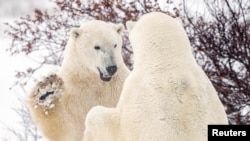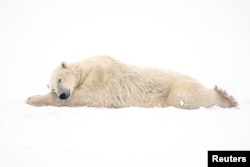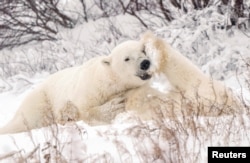A new report suggests Canada’s Western Hudson Bay polar bear population has dropped 27 percent during the past five years.
Every autumn, bears living along the western edge of the Hudson Bay pass through the sub-Arctic town of Churchill, Manitoba. The yearly movement has helped make the area’s bears one of the most studied groups in the world. Bear-watching adds about $5.3 million to the local economy each year.
But a report recently issued by the government in Canada’s northern territory of Nunavut found that just 618 polar bears remained in the area in 2021. This represented a 50 percent drop in the population from the 1980s.
Polar bears depend on frozen salt water, called sea ice, to help them hunt seals for food. But the Arctic is now warming about four times faster than the rest of the world. Around Hudson Bay, seasonal sea ice is melting earlier in the spring, and forming later in the fall. This is forcing bears to go longer periods without food.
John Whiteman is chief research scientist at the nonprofit conservation group Polar Bears International. Speaking to Reuters news agency, he called the population drop "totally shocking." Whiteman said scientists fear that if continued sea ice loss cannot be stopped, it will one day lead to a total loss of the area’s polar bear population.
Scientists warned that a direct link between the population drop and sea ice loss in Hudson Bay is not fully clear. This is because four of the past five years have seen reasonably good ice conditions. Experts say climate-caused changes affecting the local sea population might also be driving polar bear numbers down.
Scientists are also concerned because the rate of population decline has sped up in recent years. Between 2011 and 2016, for example, the polar bear population dropped just 11 percent.
There are 19 populations of polar bears spread out among Russia, Alaska, Norway, Greenland and Canada. But Western Hudson Bay is one of the southernmost populations. Scientists predict the bears there are likely to become among the first to disappear.
A 2021 study in the journal Nature Climate Change found most of the world's polar bear populations are in danger of collapsing by 2100 if worldwide carbon emissions are not heavily reduced.
Researchers said the number of deaths in young bears and female bears in Western Hudson Bay is worrisome.
“Those are the types of bears we’ve always predicted would be affected by changes in the environment,” said Stephen Atkinson. He was a lead writer of the government report and has studied polar bear populations for more than 30 years.
Young bears need energy to grow and cannot survive long periods without enough food. Female bears struggle because they use up a lot of energy caring for young bears.
Atkinson said the ability of polar bears in the Western Hudson Bay to reproduce will decrease, “because you simply have fewer young bears that survive and become adults.”
I’m Bryan Lynn.
The Associated Press and Reuters reported on this story. Bryan Lynn adapted the reports for VOA Learning English.
______________________________________________________________________
Words in This Story
conservation – n. an organized effort that aims to protect animals, plants and natural resources
emission – n. the act of producing or sending out something (such as energy or gas) from a source
type – n. a person or thing that is part of a group of people or things that have similar qualities
decline – n. a decrease
______________________________________________________________________
What do you think of this story? We want to hear from you. We have a new comment system. Here is how it works:
- Write your comment in the box.
- Under the box, you can see four images for social media accounts. They are for Disqus, Facebook, Twitter and Google.
- Click on one image and a box appears. Enter the login for your social media account. Or you may create one on the Disqus system. It is the blue circle with “D” on it. It is free.
Each time you return to comment on the Learning English site, you can use your account and see your comments and replies to them. Our comment policy is here.











Forum